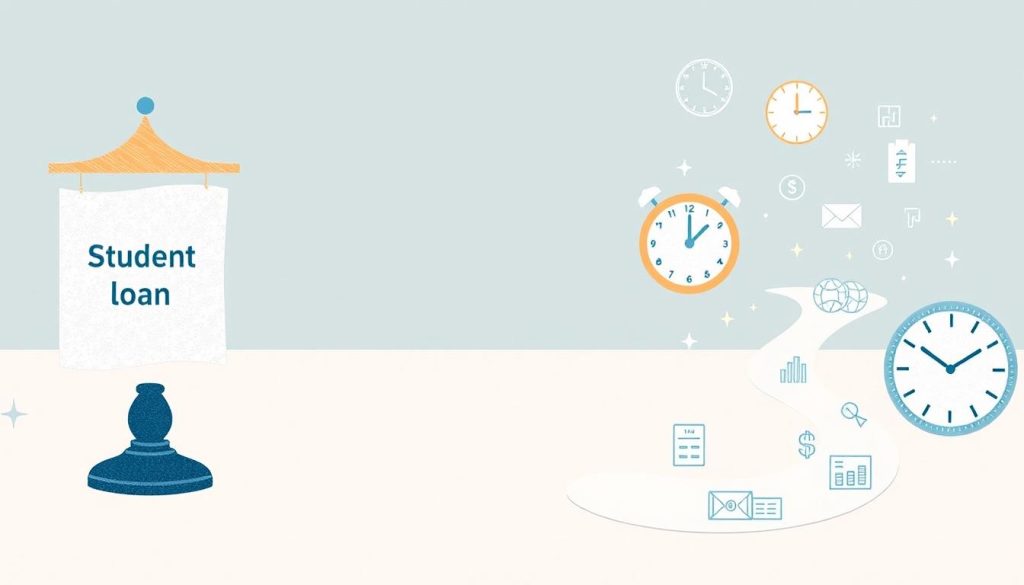Now that the pause on federal student loan payments and interest has ended, borrowers need to focus on their repayment plans. Managing student loans can be tough, but knowing your options is key to financial health. There are many federal student loan repayment plans to choose from, like standard, income-driven, graduated, and extended repayment.
It’s important to balance loan repayment with other financial goals, like saving for retirement and building an emergency fund. Federal loans often have flexible repayment plans and forgiveness options not found in private loans. By looking at interest rates, repayment terms, and forgiveness possibilities, borrowers can pick the best plan for them. This helps in achieving successful student loan repayment.
Understanding the Basics of Student Loan Repayment
It’s key to know the different student loan types, like federal and private loans. Each has its own rules for paying back the loan. Federal loans often have more flexible options, like income-driven plans and forgiveness programs.
Repayment starts six months after you graduate or drop below half-time. It’s important to understand the repayment terms. For example, the standard plan lasts 10 years. Income-driven plans can last 20 or 25 years, with payments based on your income.
Types of Student Loans
There are many student loan types, including federal and private loans. Knowing the differences is crucial for making smart repayment choices.
When Repayment Begins
Repayment starts after a six-month grace period. During this time, interest may build up. It’s important to know the repayment terms to avoid default and successfully pay back your loan.
Key Terms to Understand
Learning about terms like deferment and forbearance helps with repayment. Knowing these basics and loan types helps you manage your debt better and make informed repayment decisions.
Student Loan Repayment Plans Explained
Managing student loan debt means knowing about repayment plans. There are many loan options to choose from. Each has its own good and bad points.
Income-driven plans adjust payments based on your income and family size. This helps those who find it hard to pay back. For those with little or no income, payments can even be $0.
Plans like Income-Based Repayment (IBR) and Pay As You Earn (PAYE) set payments at a percentage of your income. IBR asks for 15% of what you can afford, while PAYE wants 10%. These plans are a big help for those who are struggling.
Choosing the right repayment plan is key. It’s important to look at all your options. This way, you can make smart choices about your student loan management and secure your financial future.
Income-Driven Repayment Options
For those finding it hard to pay back loans, income-driven plans offer a flexible solution. These plans adjust payments based on your income and family size. This could lead to loan forgiveness. Payments can be 5% to 20% of your discretionary income, depending on the plan.
There are several income-driven plans, like Income-Based Repayment (IBR) and Pay As You Earn (PAYE). Each has its own rules and benefits, like forgiveness after 20 or 25 years. For example, SAVE plan borrowers might get forgiveness in 10 years if they have low balances.
Key Benefits of Income-Driven Repayment
Income-driven plans help avoid default and delinquency. They make sure payments fit your income, preventing financial strain. They also offer loan forgiveness, a big plus for those struggling to pay.
Eligibility and Application
To qualify, you need to show a partial financial hardship. Apply through your loan servicer, who checks your income and family size. It’s crucial to know your plan’s details, like forgiveness options and recertification needs.
Standard and Extended Repayment Plans
Borrowers have several options to manage their student loan debt. The standard repayment plan has a fixed monthly payment for 10 years. It’s great for those who want to pay off their loans fast and save on interest.
The extended repayment plan offers a longer time to repay, from 12 to 30 years. It’s good for those who need more time and want lower monthly payments. However, it might mean paying more interest over time.
Extended repayment plans can help with high debt by lowering monthly payments. But, it’s important to think about the extra interest you might pay. Loan management is key to avoid default and making timely payments. Choosing the right plan helps borrowers control their debt and work towards financial freedom.
With standard repayment, you make fixed payments for a set time. It’s often the cheapest option, helping you pay off your loans quickly and save on interest. Extended repayment plans offer more flexibility with longer periods and possibly lower payments. Knowing the differences helps borrowers make the best choice for their finances.
Loan Forgiveness and Discharge Options
For those struggling with student loan debt, loan forgiveness and discharge options can offer relief. These choices are for borrowers who meet specific criteria, like working in public service or teaching. For instance, the public service loan forgiveness program forgives loans after 10 years of qualifying payments for government or non-profit workers.
The teacher loan forgiveness program is another option. It forgives up to $17,500 for teachers in low-income areas after five years of full-time teaching. Borrowers can also consider disability discharge options. These options wipe out federal student loans for those with a total and permanent disability.
There are also income-driven repayment plans. These plans can lead to loan forgiveness after 20 or 25 years of payments. It’s crucial for borrowers to know the eligibility and application process for each option. This helps them choose the best path for their situation.
How to Choose the Right Repayment Plan
Choosing the right repayment plan is key for managing loans well. Think about your income, family size, and financial goals. The U.S. Department of Education has many plans, like Pay As You Earn (PAYE) and Income-Contingent Repayment (ICR). These plans help you manage your payments.
It’s important to look at all your options for repayment. Pick a plan that fits your financial situation. For example, PAYE caps payments at 10% of what you can afford. ICR offers $0 payments for some, based on income.

When picking a plan, avoid common mistakes. Don’t ignore your loan servicer or skip plan reviews. Also, be aware that some plans might cost more in the long run because of interest. Getting advice on student loans can help you make the right choice.
It’s crucial to regularly check if your repayment plan still works for you. If your income or family size changes, you might need to adjust your plan. Being informed and proactive helps you manage your debt better and reach financial stability.
Managing Your Student Loan Payments
Effective loan management is key to avoiding default and making timely student loan payments. To do this, set up automatic payments and keep an eye on your account. Also, stay in touch with your loan servicer. If you’re having trouble, think about consolidating your loans or looking into income-driven repayment plans. These steps can make your payment tips easier and help manage your debt.
The Income-Contingent Repayment Plan is a good option for those needing more flexibility. It bases monthly payments on 20% of your discretionary income or what you’d pay over 12 years, whichever is less. The Extended Repayment Plan offers fixed or graduated payments and can extend up to 25 years for borrowers owing over $30,000.
By following these payment tips and keeping up with your loan management, you can avoid default. It’s also wise to review and adjust your repayment plan every year. With the right plan and commitment to timely payments, you can manage your student loan debt and reach financial stability.
Conclusion: Taking Control of Your Student Loan Journey
As you deal with student loan repayment, it’s important to take charge of your financial future. Knowing your loan repayment options helps you make smart choices. This is true whether you’re just beginning or looking to change your plan.
Regularly checking your loan plan and doing financial planning is essential. Look into the tools and resources available to help you manage your loans. If you need help, don’t be afraid to ask experts. Being proactive and flexible will help you manage your loans well and reach financial stability.
Student Loan Repayment Plans FAQ
What are the different types of student loans?
Student loans come in two main types. Federal loans are from the government. Private loans are from banks and other lenders. Federal loans often have better repayment options and benefits.
When does student loan repayment begin?
Repayment usually starts 6 months after you graduate or drop below half-time. But, the exact start date can vary by loan type.
What are the key terms to understand when it comes to student loan repayment?
Key terms include principal, interest, grace period, deferment, and forbearance. Knowing these terms helps you manage your loans better.
What are the different types of student loan repayment plans?
There are several plans like standard, extended, graduated, and income-driven. Each has its own rules, payments, and periods.
What are the income-driven repayment options?
Income-driven plans like IBR, PAYE, REPAYE, and ICR adjust payments based on income and family size. They offer more flexibility for those struggling to pay.
What are the standard and extended repayment plans?
The standard plan has a 10-year fixed payment. The extended plan stretches to 12 to 30 years, with lower payments but more interest.
What are the loan forgiveness and discharge options?
Forgiveness and discharge options include Public Service Loan Forgiveness and Teacher Loan Forgiveness. They can save borrowers thousands by wiping out their loans.
How do I choose the right repayment plan?
Consider your income, family size, and goals when choosing a plan. Avoid mistakes like not exploring all options. Regularly review your plan to ensure it fits your situation.
How can I effectively manage my student loan payments?
Manage payments by setting up automatic payments and checking your account often. Talk to your servicer if you’re struggling. Consider consolidating or income-driven plans if needed.
